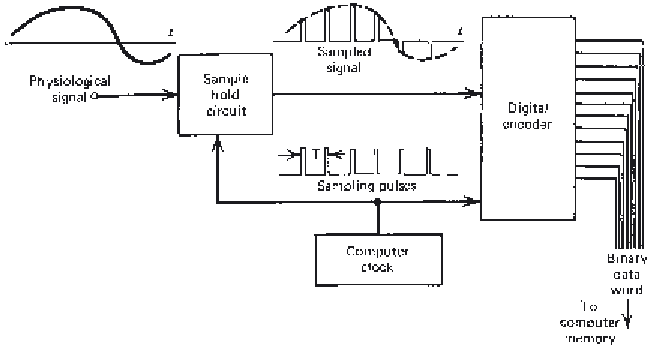Biomedical Engineering Reference
In-Depth Information
Figure 2.11
Schematic diagram showing the steps involved in an analog-to-digital
conversion of a physiological signal.
force, an acceleration, an electromyographic (EMG) potential, or the like is
fed into the input terminals of the analog-to-digital converter. The computer
controls the rate at which the signal is sampled; the optimal rate is governed
by the sampling theorem (see Section 2.2.4.2).
Figure 2.11 depicts the various stages in the conversion process. The first
is a sample/hold circuit in which the analog input signal is changed into a
series of short-duration pulses, each one equal in amplitude to the original
analog signal at the time of sampling. The final stage of conversion is to
translate the amplitude and polarity of the sampled pulse into digital format.
This is usually a binary code in which the signal is represented by a number
of bits. For example, a 12-bit code represents 2
12
=
4096 levels. This means
that the original sampled analog signal can be broken into 4096 discrete
amplitude levels with a unique code representing each of these levels. Each
coded sample (consisting of 0s and 1s) forms a 12-bit “word,” which is
rapidly stored in computer memory for recall at a later time. If a 5-s signal
were converted at a sampling rate of 100 times per second, there would be
500 data words stored in memory to represent the original 5-s signal.
2.2.4.2 Deciding the Sampling Rate — The Sampling Theorem.
In the
processing of any time-varying data, no matter what their source, the sampling
theorem must not be violated. Without going into the mathematics of the
sampling process, the theorem states that “the process signal must be sampled
at a frequency at least twice as high as the highest frequency present in the
signal itself.” If we sample a signal at too low a frequency, we get aliasing
errors. This results in false frequencies, frequencies that were not present in
the original signal, being generated in the sample data. Figure 2.12 illustrates










Search WWH ::

Custom Search